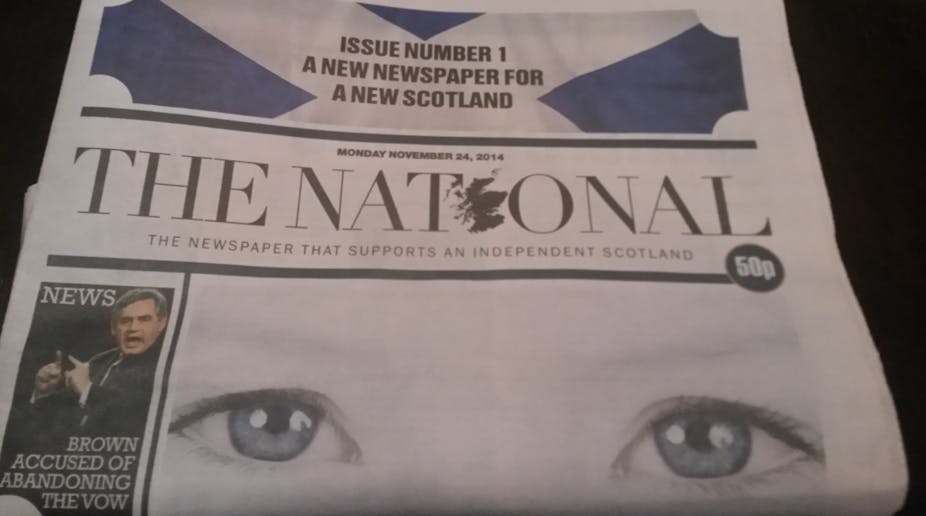There is no copyright in titles, although I must admit when I heard that the name of the new Scottish daily newspaper launched this week was The National, I was momentarily thrown. That is also the name of the long-running late evening news bulletin on the Canadian Broadcasting Corporation’s main television channel, not to mention an English-language newspaper in the Middle East. But it is a title which both commands attention and signifies ambition, which is no doubt why it has been chosen for the new paper.
Launching a new title in the current climate is very brave. Newspapers throughout the Western world have been struggling with falling circulations and revenues. Their attempts – belatedly – to impose paywalls on their online versions, as many have now do, have not yet secured the revenue needed to compensate for the decline of traditional print circulation and advertising streams.
And there is the additional problem of the apparent indifference of many young people to newspapers. In Scotland the situation has been compounded for indigenous titles, which have not only lost circulation in absolute terms but have also seen their market share eroded by English titles, with or without Scottish editions. Fewer than half the papers bought in Scotland on a weekday are produced in the country; the figure is just over half on Sundays.
Indyref press coverage
The referendum campaign was one in which the press, both Scottish and English, was firmly on the No side (which won 55/45 in the end). This might not have mattered if all the papers had offered balanced reporting of the issues. Upmarket titles did attempt such coverage, for the most part, but that was not the case with many of the tabloids.
The only paper that argued in favour of independence was the Sunday Herald; its stablemate the daily Herald remained in the unionist camp, albeit offering balanced coverage and harbouring several pro-Yes columnists, who were given a lot of space to air their views.

After the Sunday title “came out” in May, its circulation more than doubled to almost 50,000 and is now thought to have settled around 35,000. So it is not really surprising that the Herald group’s ultimate owner, the Gannett corporation of the US, has backed a new pro-independence daily.
Proof is in the inking
What is striking, however, is that The National is not being given very long to prove that there is a market. With a print run of 50,000 it has to demonstrate by the end of this week that it has a future. An online edition is promised if all goes well.
The first edition is priced at 50p and has 32 pages. Only a few of those are taken up by advertising, which is not surprising, given that the preparations for the production of the paper were kept secret until late last week. The overall design is clean, attractive and uncluttered.
There are a number of stories with a clear independence/devo-max slant, often with a leftish hue, starting with a splash that reports that 60 Scottish charities are calling for Holyrood to be handed control over welfare.
The National also reports that the Scottish National Party’s Westminster leader Angus Robertson is accusing Gordon Brown of abandoning his promise to ensure the three main UK parties’ pre-referendum “vow” is delivered; and that the Radical Independence Campaign is to launch a new fight against NHS privatisation.
There are four pages of world news, including a feature piece on the president of Iran, and an extended report on the Tunisian election. There are four pages of business news and five of sport, including a double-page profile of Formula 1 winner Lewis Hamilton.
What is noticeable, however, is the lack of many Scottish and “rest of UK” news stories outside of the paper’s central agenda. A comparison with the sister paper, The Herald, makes that very clear. It is also obvious that not many journalists have been allocated to the paper, particularly if it is fair to assume that “James”, “Jamie” and “Jamies” Maxwell are all the same person.
Who will buy The National?
So what audience does the editor Richard Walker (who also edits the Sunday Herald) have in mind? I would tend to think it is less tabloid than mid-market readers, composed of those who are not only keen on independence or some kind of federal solution but also want to know what is going beyond the UK, are interested in business and sport, but are not football fanatics (a more distilled version of the Sunday Herald, perhaps?).
What the paper lacks at this admittedly early stage, apart from television listings, which can be found elsewhere, are columnists of bite. Presumably if the paper is a success, then such individuals will be found.
Will the paper last as long as its Canadian namesake has on air? Perhaps that is unlikely in the current market, even if the paper does find the pro-independence audience it is seeking. That said, it would be churlish not to welcome the appearance of The National to Scottish newsstands.

